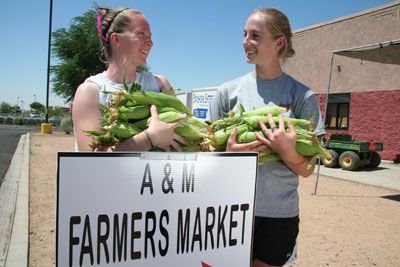Arizona Agriculture's Exciting Organic Farming Numbers
Published
6/13/2013
By Steven Manheimer, Arizona Agricultural Statistics, USDA; with contributions from Julie Murphree, Arizona Farm Bureau: We’re eager to see the newest numbers on Arizona agriculture and specifically our organic agriculture in Arizona. Unfortunately, we’ll have to wait until 2014 to uncover what the latest Agriculture Census by the USDA tells us. In the meantime, we can look at the numbers from the last census and the specific 2008 organic numbers.

What does an organic farm in Arizona look like? One size does not fit all. According to the results of the 2008 Organic Production Survey, Arizona had 63 organic farms, covering nearly 21,000 acres of land. The average organic operation in Arizona has 350 acres of land, larger than the 285 acres for an average organic farm nationwide. These organic farms also produced sales of more than $42 million. But, when you drill deeper into the data, pictures of two distinct types of organic farms emerge.
Did you know that nearly 58 percent of all organic farms had sales of less than $50,000 per farm? These smaller operations may be those that sell primarily to local markets and restaurants. Another characteristic of these smaller operations is that many of them produce nothing but organic production. On the other end of the spectrum, another 31 percent of organic farms had sales totaling more than $500,000 per farm. These most likely are operations that sell directly to large supermarkets and other large outlets. These large organic farms also accounted for more than 96 percent of total sales and organic commodities most likely
Arizona’s Organic Farms Grow a Variety of Fruits and Vegetables
What do these organic farms grow? As you might expect, vegetables and melons are two widely grown commodities. Nearly one-third of all organic farms produced vegetables, melons or potatoes. Apples were also grown organically in Arizona with 10 growers reporting sales of nearly $4.2 million. Other fruit crops produced included grapes, peaches, pears and citrus. Other types of crops were also produced including barley, dry beans, corn, cotton, hay, sorghum, sunflower seed and durum wheat. Organic milk and beef cows, hogs, sheep, goats, and chickens were also produced.
The organic production in Arizona comes at a high price. In 2008, the organic production expenditures in the state in 2008 totaled more than $37 million. As you might expect, farm labor was the largest production expense totaling $9.7 million.
The Organic Production Survey also asked a series of questions to gauge the adoption of various production practices on certified or exempt farms. The top five practices used in terms of
Marketing practices were also part of the survey. A large percentage of reported organic sales were to wholesale outlets although direct sales to retail and consumer outlets
According to the results of the 2008 Organic Production Survey, organic production in Arizona will grow over the next five years. Nearly 67 percent of all respondents said that they expect to increase or maintain their organic production. Nine farms in Arizona also reported cropland in transition to organic production.
Organic grower Arnott Duncan in Goodyear confirms these survey results. While growing a variety of organic produce, Duncan says, “We are already in the process of transitioning more ground for organic production.”
A few years back, Duncan Family Farms spearheaded the launch of the Wigwam Farmers Market in Litchfield Park. The farm currently sells their organic produce as raw material to the salad processors who distribute nationwide and in some cases, internationally. "We have always wanted to make our product available locally and are doing this with the Farmers Market and our CSA (Community Supported Agriculture) program."
Organic Agriculture throughout the United States
The 2008 Organic Production Survey counted 14,540 organic farms and ranches in the United States. Of these operations, 10,903 were USDA certified and 3,637 were exempt from certification. Organic operations comprised 4.1 million acres of land in the U.S.
U.S. organic farms and ranches had nearly $3.2 billion in total sales in 2008. Livestock products and vegetable sales accounted for nearly half of all organic sales that year. An average organic farm had annual sales of $217,675 that year. In comparison, according to the 2007 Census of Agriculture, an average U.S. farm overall had sales of $134,807.
Production expenses for certified and exempt organic farms totaled $2.5 billion in 2008. The production expenses for organic farms, at $171,978 per farm, were higher than the $109,359 average for all farms nationwide, as reported in the 2007 Census of Agriculture. The largest expense for organic farms in 2008 was labor, totaling $569 million, closely followed by feed purchases, which totaled $480 million.
As you might expect, California was the leading state for organic agriculture in 2008. With nearly 20 percent of all organic farms and ranches located in that state, California organic farmers accounted for more than a third of all organic sales in the U.S. California organic certified and exempt operations comprised more than 470,000 acres of land.
Organic production in the U.S. is projected to grow over the next five years, with more than 78 percent of certified and exempt producers indicating that they plan to maintain or increase their organic production levels.
And, as you might expect, Arizona organic production might have some catching up to do with states like California, the state’s organic farmers and ranchers have staked their claim. Says Duncan seeing the opportunity in Arizona, “I have not farmed organically anywhere else, but I would think that our dry climate would be less than favorable to certain plant diseases.”
Editor’s Note: For more census results, visit www. agcensus.usda.gov